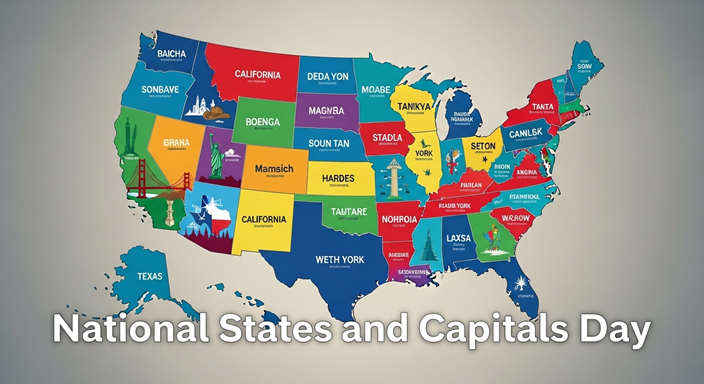Every #country is made up of diverse #states, #cities, #towns, and #regions—each contributing to the nation’s #identity, #heritage, and #governance. National States and Capitals Day (#NationalStatesAndCapitalsDay) is a unique observance that highlights the importance of #knowing, #understanding, and #celebrating the states and their capitals within a country. It is not just about memorizing geographical divisions, but about appreciating the diversity and cultural significance each state holds. By observing this day, citizens strengthen their bond with their nation while fostering awareness of its structure and governance.
History of National States and Capitals Day
The roots of National States and Capitals Day can be traced back to the United States, where geography and civics education were emphasized as part of national identity building. The day was first observed in 2017 when educational organizations and civic groups collaborated to create a celebration that would inspire young learners to connect with their states and capitals. The initiative was led by a group of educators and civic enthusiasts under the banner of the National Geographic Awareness Council.
Over time, this observance spread beyond classrooms and schools, gaining recognition from local governments and communities. It was later adopted in other regions of the world where countries wanted to instill greater awareness of their administrative divisions. While the exact date may vary in different countries, the goal remains the same: to honor and recognize the importance of states and their capitals.
Importance of the Day
The importance of National States and Capitals Day lies in its ability to connect citizens with their nation’s geography, governance, and diversity. States represent unique cultural, historical, and political units, and their capitals act as administrative and symbolic hubs. By learning about them, citizens:
-
Gain a stronger understanding of their national structure.
-
Appreciate the diversity that each state brings to the nation.
-
Develop civic responsibility and national pride.
-
Strengthen their sense of unity while celebrating regional identities.
In an era of globalization, such observances remind people of their roots and the internal strength of their nation.
Significance of National States and Capitals Day
The significance of the day goes beyond geography lessons. It acts as a bridge connecting history, culture, politics, and education. Here’s why it is significant:
-
Cultural Awareness – States often carry unique traditions, languages, and cuisines. Their capitals are usually cultural hotspots where this diversity is celebrated.
-
Civic Education – Understanding the political role of a state capital fosters better citizenship and awareness of governance.
-
Educational Growth – The day motivates schools and institutions to engage students in fun, interactive activities like quizzes, map drawing, and cultural exhibitions.
-
National Integration – While states may have distinct identities, the day symbolizes how these parts come together to form a united whole.
Why It Is Celebrated
The observance of National States and Capitals Day has three core purposes:
-
Educational Purpose: To strengthen knowledge of geography and civics among citizens, especially students.
-
Cultural Purpose: To celebrate the unique traditions, dialects, and histories of each state.
-
National Purpose: To foster unity while embracing diversity.
Celebrating the states and their capitals gives people a chance to reflect on the importance of each region, understand its contribution, and take pride in the nation’s collective identity.
How It Is Celebrated?
Celebrations vary from one region to another, but they usually involve:
-
Educational Programs – Schools organize map-based competitions, state quizzes, and exhibitions showcasing the culture of each state.
-
Cultural Shows – Capitals are often represented through cultural performances, folk dances, and cuisine festivals.
-
Awareness Campaigns – Social media drives, posters, and interactive games encourage citizens to learn state-capital facts.
-
Community Events – Local organizations arrange parades, flag displays, or interactive geography lessons for families.
-
Digital Celebrations – Online campaigns encourage participants to share interesting facts about their states and capitals using hashtags.
Countries or Regions Where the Day Is Celebrated
Though it began in the United States, the spirit of National States and Capitals Day has been embraced in many countries where states, provinces, or territories play an important role in governance. Countries such as India, Australia, Canada, and Brazil have observed similar initiatives to encourage their citizens to know their states and capitals.
-
India: With 28 states and 8 Union Territories, each having its own capital, the day has been integrated into school education and cultural celebrations.
-
Canada: Focuses on its provinces and territories, with capitals highlighted in educational campaigns.
-
Australia: State capitals are celebrated with interactive events and community programs.
-
Brazil: State capitals are central to cultural identity, and similar observances foster pride among citizens.
How Citizens Involve Themselves in the Celebration
Citizens play a key role in making this day successful. They:
-
Participate in quizzes, debates, and school competitions.
-
Share facts and cultural stories of their states and capitals on social media.
-
Volunteer in community events that celebrate regional diversity.
-
Encourage children to learn about states and their capitals through fun activities like puzzles and flashcards.
-
Visit their state capitals to experience history and governance firsthand.
When people actively engage, the day transforms from a formal observance into a living celebration of national unity.
Theme for 2025
The theme for National States and Capitals Day 2025 is:
“Mapping Unity, Celebrating Diversity.”
This theme emphasizes that while every state and capital is unique, together they create a map of unity that defines the nation. The focus is on cultural inclusivity, educational awareness, and fostering national pride through shared knowledge of states and capitals.
10 Famous Quotes for National States and Capitals Day
-
“A nation’s strength lies in the unity of its states and the pride of its people.”
-
“Capitals are not just cities; they are the beating hearts of their states.”
-
“Learning our states and capitals is learning the soul of our nation.”
-
“Diversity of states, unity of hearts—that’s what makes a nation strong.”
-
“Capitals symbolize leadership, culture, and the spirit of governance.”
-
“A map is not just geography; it is a story of identity.”
-
“The roots of unity grow from the soil of every state.”
-
“When we know our states, we understand our nation better.”
-
“Every state is a chapter, every capital a headline, in the nation’s story.”
-
“Celebrate diversity, honor unity—know your states and capitals.”
Frequently Asked Questions (FAQs)
Q1. What is National States and Capitals Day?
It is a day dedicated to learning, appreciating, and celebrating the states and their capitals within a country.
Q2. When is National States and Capitals Day celebrated?
It is generally observed in September in the United States, but dates may vary in other countries.
Q3. Why was National States and Capitals Day started?
It was initiated in 2017 by educators and civic groups to promote geography and civic awareness.
Q4. Is National States and Capitals Day celebrated worldwide?
While it originated in the US, similar observances are now celebrated in countries like India, Canada, Brazil, and Australia.
Q5. Who benefits from this celebration?
Students, educators, and citizens benefit by strengthening their civic knowledge and cultural awareness.
Q6. What activities are held on this day?
Quizzes, map competitions, cultural shows, and community events are common.
Q7. Why are state capitals important?
Capitals serve as administrative, cultural, and political hubs of states.
Q8. What is the theme for National States and Capitals Day 2025?
The theme for 2025 is “Mapping Unity, Celebrating Diversity.”
Q9. How can citizens celebrate at home?
They can teach children about states, play geography games, and share cultural facts online.
Q10. Does this day strengthen national unity?
Yes, it promotes unity by celebrating the diversity of states and the role of their capitals.
Conclusion
National States and Capitals Day is more than a geographical observance; it is a celebration of national identity, cultural richness, and unity. By learning about states and their capitals, citizens honor the diversity of their nation while strengthening their connection to its governance and culture. The observance reminds us that every state matters, every capital has meaning, and together, they form the vibrant fabric of a nation. As we celebrate this day in 2025 with the theme “Mapping Unity, Celebrating Diversity,” let us pledge to embrace our differences while standing united under one nation.
|
!!! Stay Updated !!! 👉 Follow and Join us on 👈 📰 Trending News | 📢 Important Alerts | 💼 Latest Jobs LinkedIn | Threads | Facebook |Instagram | Tumblr 📱 Follow us daily & never miss an update 📱 |

Someshwar Chowdhury is a seasoned Chartered Mechanical Engineer, Educator, and Technology enthusiast with over a decade of experience in engineering education and consultancy. Someshwar is also an active blogger, trainer, and member of professional bodies like ISHRAE and GREEN ADD+. When not teaching or consulting, he enjoys blogging, music, and exploring green technologies.
Discover more from Today's Significance
Subscribe to get the latest posts sent to your email.
